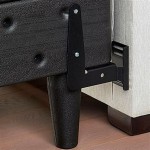At What Age Can a Child Sleep in a Loft Bed?
Loft beds, with their elevated sleeping platform and built-in storage space, offer a unique and space-saving solution for children's bedrooms. However, before making the decision to transition your child to a loft bed, it's crucial to consider their age and developmental stage. While there's no set age for when a child is "ready" for a loft bed, understanding the potential benefits and risks associated with these beds can help parents make an informed choice.
Factors to Consider for Choosing a Loft Bed
When deciding if a loft bed is appropriate for your child, several factors come into play. These include:
- Age: The minimum age for a loft bed varies depending on the design and safety features. Generally, most manufacturers recommend a minimum age of 6 years old. However, it's essential to assess your child's individual maturity level and physical capabilities.
- Maturity and Responsibility: Loft beds require a certain level of responsibility, as children must be able to navigate stairs and understand the potential hazards associated with heights. It's important to ensure they can climb and descend stairs safely and independently.
- Physical Development: Children's physical abilities and coordination vary. Consider your child's height and strength, as well as their ability to balance and maintain stability. A young child who is still developing physically may struggle with navigating the stairs or maintaining balance on the elevated platform.
- Safety Features: Look for loft beds with safety features such as guardrails, sturdy ladders, and non-slip steps. These features can help minimize the risk of falls and accidents.
- Space Requirements: Loft beds require adequate ceiling height and floor space to ensure safe access and prevent injuries. Measure your child's room carefully before purchasing a loft bed.
Potential Benefits of Loft Beds
Loft beds can provide several advantages for children and families:
- Space Saving: Loft beds maximize floor space, providing valuable room for play, study, or storage. This is especially beneficial in smaller bedrooms or homes.
- Enhanced Organization: Built-in storage compartments, shelves, or desks underneath the loft bed can promote organization and tidiness in a child's room.
- Sense of Independence: A loft bed can create a sense of privacy and autonomy for a child, allowing them to personalize their space and feel more independent.
- Fun and Creative Play: Loft beds can inspire imaginative play, with the elevated platform serving as a fort or a playhouse. This can be particularly appealing to children who enjoy imaginative games.
Potential Risks Associated with Loft Beds
It's important to be aware of the potential dangers associated with loft beds:
- Falls: One of the most significant risks associated with loft beds is the possibility of falling. It's essential to ensure your child understands the importance of being careful when climbing and descending the stairs and using the guardrails.
- Injuries: Falls from a loft bed can result in serious injuries, such as head trauma, broken bones, or sprains. It's crucial to take all safety precautions to minimize these risks.
- Entrapment: Children can become trapped between the bed's frame and the wall or between the bed and furniture if the bed is positioned too close to these objects. Ensure adequate clearance for the bed.
- Suffocation: There is a risk of suffocation if a young child is unable to move away from the bed's side or if items are placed on the bed that could obstruct airflow.
Recommendations for Safe Loft Bed Use
To minimize the risk of accidents and ensure safe use of a loft bed, consider the following recommendations:
- Choose a Bed with Robust Safety Features: Opt for a loft bed with sturdy guardrails, secure ladders, and non-slip steps. Make sure the platform and ladder are well-constructed and can withstand the weight of your child.
- Supervise Children: Supervise your child closely when they are using the loft bed, especially during the initial transition period. Encourage them to practice climbing and descending the stairs safely.
- Establish Clear Rules: Set clear rules about using the loft bed, such as no running or jumping on the platform, always using the ladder to climb and descend, and not placing objects on the bed that could create a fall hazard.
- Maintain Proper Distance: Ensure the bed is placed far enough away from walls and other furniture to prevent entrapment and allow for airflow.
- Regular Inspections: Regularly inspect the bed for loose screws, damaged parts, or any signs of wear. Replace any parts that are worn or damaged to ensure continued safety.
Ultimately, the decision to purchase a loft bed for your child depends on several factors, including their age, maturity level, and physical development. By carefully considering these factors and taking necessary safety precautions, parents can make an informed choice that promotes both comfort and safety for their child.

From Toddler To Teen A Guide Kids Beds For Every Age Cuckooland

How To Decide If A Loft Bed Is Right For You

Everything Pas Should Know About Bunk Beds Cuckooland

When Is Your Child Ready For A Bunk Bed We Would Like To Talk About It

What Age Can A Child Sleep On Top Bunk Bed

Everything Pas Should Know About Bunk Beds Cuckooland

Loft Beds For Kids We Love Now Today S Pa
At What Age Is It Safe To Allow Your Kids Sleep In A Bunkbed Quora

Everything Pas Should Know About Bunk Beds Cuckooland

Boy S Natural Queen Loft Bed With Desk Room Reveal Maxtrix Kids
Related Posts







